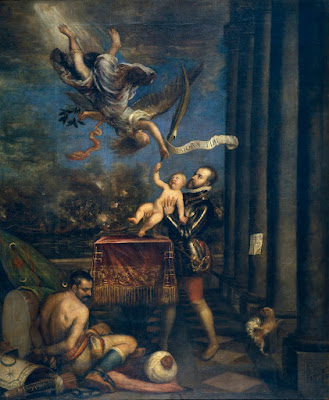 |
| Titian Christ carrying the Cross, helped by Simon the Cyrenian ca. 1560 oil on canvas Museo del Prado, Madrid |
 |
| Titian and workshop Allegory of Prudence (Three Ages of Man) ca. 1560-65 oil on canvas National Gallery, London |
 |
| Titian Self Portrait ca. 1562 oil on canvas Gemäldegalerie, Berlin |
 |
| Titian Self Portrait ca. 1562 oil on canvas Museo del Prado, Madrid |
 |
| Titian Christ on the Cross with the Good Thief ca. 1563 oil on canvas Pinacoteca Nazionale di Bologna |
 |
| Titian Venus blindfolding Cupid ca. 1565 oil on canvas Galleria Borghese, Rome |
 |
| Titian Christ carrying the Cross, helped by Simon the Cyrenian ca. 1565 oil on canvas Museo del Prado, Madrid |
 |
| Titian St Catherine of Alexandria at Prayer ca. 1567 oil on canvas Museum of Fine Arts, Boston |
 |
| Titian Portrait of collector and polymath Jacopo Strada 1567-68 oil on canvas Kunsthistorisches Museum, Vienna |
 |
| Titian Ecce Homo ca. 1570-75 oil on canvas Saint Louis Art Museum |
 |
| Titian The Entombment 1572 oil on canvas Museo del Prado, Madrid |
 |
| Titian Spain succouring Religion at Lepanto 1572-75 oil on canvas Museo del Prado, Madrid |
 |
| Titian Philip II and Infante Don Fernando celebrating the Victory at Lepanto 1573-75 oil on canvas Museo del Prado, Madrid |
 |
| Titian St Jerome in Penitence ca. 1575 oil on canvas Museo Thyssen-Bornemisza, Madrid |
"When Vasari, the writer of this history, was at Venice in the year 1566, he went to visit Tiziano, as one who was much his friend, and found him at his painting with brushes in his hand, although he was very old; and he had much pleasure in seeing him and discoursing with him. . . . It is true, however, that the method of work which he employed in these last pictures is no little different from the method of his youth, for the reason that the early works are executed with a certain delicacy and a diligence that are incredible, and they can be seen both from near and from a distance, and these last works are executed with bold strokes and dashed off with a broad and even coarse sweep of the brush, insomuch that from near little can be seen, but from a distance they appear perfect. This method has been the reason that many, wishing to imitate him therein and to play the practised master, have painted clumsy pictures; and this happens because, although many believe that they are done without effort, in truth it is not so, and they deceive themselves, for it is known that they are painted over and over again, and that he returned to them with his colours so many times, that the labour may be perceived. And this method, so used, is judicious, beautiful, and astonishing, because it makes pictures appear alive and painted with great art, but conceals the labour."
– from Lives of the Painters, Sculptors and Architects by Giorgio Vasari (1568), translated by Gaston du C. de Vere (1912)